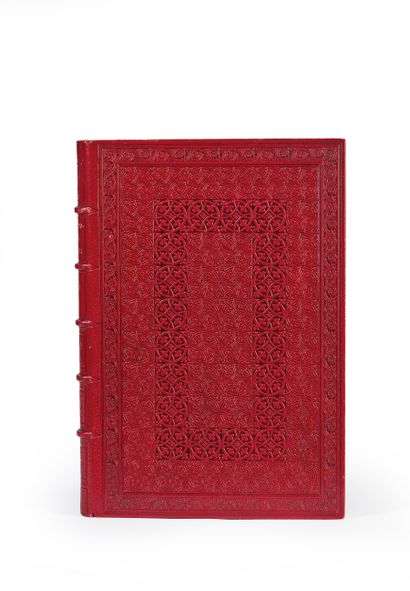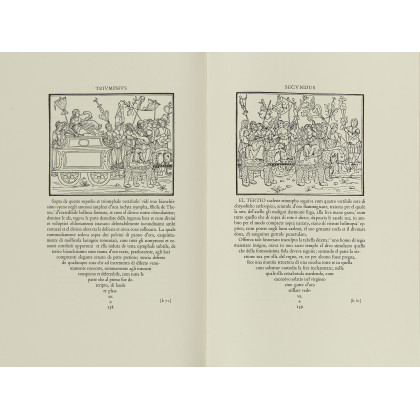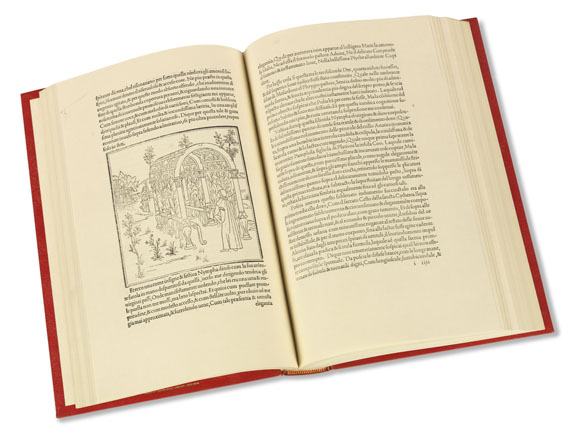COLONNA, Francesco (1433-1527). Hypnerotomachia Poliphili, ubi humana omnia non nisi somnium esse docet. Atque obiter plurima scitu sane quam digna commemorate . Venice: Aldus Manutius for Leonardus Crassus, December 1499.
COLONNA, Francesco (1433-1527). Hypnerotomachia Poliphili, ubi humana omnia non nisi somnium esse docet. Atque obiter plurima scitu sane quam digna commemorate . Venice: Aldus Manutius for Leonardus Crassus, December 1499. Aldine 2 o (305 x 200mm). Collation: \Kp\k 4 (preliminary matter, including Crassus's letter to Guidobaldo da Montefeltro, verse by Johannes Baptista Scytha and Andreas Maro, prose and verse synopses); a-y 8 z 1 0 (Book I); A-E 8 F 4 (Book II, epitaphs, errata and colophon). 233 leaves (of 234; final leaf, errata, supplied in facsimile). Roman types 115 (evolved from 2:114), cut by Francesco Griffo, and 10:82 (first title), Greek type 7:114 (occasional words) and square Hebrew (b8). 172 WOODCUTS, including 11 full-page illustrations, attributed to BENEDETTO BORDON 39 woodcut initials (17 blocks) form an acrostic including the author's name. (Light marginal staining, but worse in quire b.) Late-17 t h -century Dutch calf, gilt spine, marbled pastedowns, Dutch flyleaves, (rubbed, headcap chipped, split in joints). Provenance : G.B.B. Sorieri (16th-century entry at top of title) -- F. Pona (manuscript note on early paper mounted under Polia's epitaph in the lower blank margin of F3v, dated October 1635, recording his detection of the acrostic); this is probably the physician, poet and philosopher, FRANCESCO PONA (1595-1655), author of La Lucerna di Eureto Misoscolo 1625, Gli Amori discordi 1633, and translator of Ovid and Barclay's Argenis -- Acquired from Goodspeed's Book Shop 1966. FIRST EDITION OF THE MOST ACCLAIMED ILLUSTRATED PRINTED BOOK OF THE ITALIAN RENAISSANCE. Much influenced by the architectural theories of Vitruvius and Alberti, this allegorical romance, relating Poliphilo's wanderings in pursuit of his beloved Polia through mythical landscapes filled with antique palaces, temples, ruins, pyramids, obelisks and other structures, must be read as a treatise on art and aesthetics. The book was written in what may be described as Latinate Italian and consciously designed as a work of art through the extraordinary integration of text, typography and illustration. It greatly influenced artists and designers as can be seen in the classical ornament of late-Renaissance Italy and especially France. In the dedicatory letter Leonardus Crassus reveals himself as the publisher, but it is the as yet unidentified creator of the woodcuts (two are signed with a lower-case b) who was no doubt responsible for designing the book, presumably in collaboration with the author and the printer. Aldus produced no other fully illustrated book and printed very little else on commission. The Vershbow copy shows the most common settings (including the stamping in the second title, see GW Anm. 2); see for variant settings Ph. Hofer, "Variant copies of the 1499 Poliphilus," in: Bulletin of the New York Public Library 36 (1932) pp. 475-86; L. Donati, "Diciamo qualche cosa del Polifilo!" in: Maso Finiguerra 3 (1938) pp. 70-96; C. Bühler, "Newly discovered variant settings in the Hypnerotomachia Poliphili," in: Festschrift für Claus Nissen (1973) pp. 36-42. HC *5501; GW 7223; BMC V, 561; IGI 3062; Goff C-767; Essling 1198; Sander 2056.
COLONNA, Francesco (1433-1527). Hypnerotomachia Poliphili, ubi humana omnia non nisi somnium esse docet. Atque obiter plurima scitu sane quam digna commemorate . Venice: Aldus Manutius for Leonardus Crassus, December 1499.
COLONNA, Francesco (1433-1527). Hypnerotomachia Poliphili, ubi humana omnia non nisi somnium esse docet. Atque obiter plurima scitu sane quam digna commemorate . Venice: Aldus Manutius for Leonardus Crassus, December 1499. Aldine 2 o (305 x 200mm). Collation: \Kp\k 4 (preliminary matter, including Crassus's letter to Guidobaldo da Montefeltro, verse by Johannes Baptista Scytha and Andreas Maro, prose and verse synopses); a-y 8 z 1 0 (Book I); A-E 8 F 4 (Book II, epitaphs, errata and colophon). 233 leaves (of 234; final leaf, errata, supplied in facsimile). Roman types 115 (evolved from 2:114), cut by Francesco Griffo, and 10:82 (first title), Greek type 7:114 (occasional words) and square Hebrew (b8). 172 WOODCUTS, including 11 full-page illustrations, attributed to BENEDETTO BORDON 39 woodcut initials (17 blocks) form an acrostic including the author's name. (Light marginal staining, but worse in quire b.) Late-17 t h -century Dutch calf, gilt spine, marbled pastedowns, Dutch flyleaves, (rubbed, headcap chipped, split in joints). Provenance : G.B.B. Sorieri (16th-century entry at top of title) -- F. Pona (manuscript note on early paper mounted under Polia's epitaph in the lower blank margin of F3v, dated October 1635, recording his detection of the acrostic); this is probably the physician, poet and philosopher, FRANCESCO PONA (1595-1655), author of La Lucerna di Eureto Misoscolo 1625, Gli Amori discordi 1633, and translator of Ovid and Barclay's Argenis -- Acquired from Goodspeed's Book Shop 1966. FIRST EDITION OF THE MOST ACCLAIMED ILLUSTRATED PRINTED BOOK OF THE ITALIAN RENAISSANCE. Much influenced by the architectural theories of Vitruvius and Alberti, this allegorical romance, relating Poliphilo's wanderings in pursuit of his beloved Polia through mythical landscapes filled with antique palaces, temples, ruins, pyramids, obelisks and other structures, must be read as a treatise on art and aesthetics. The book was written in what may be described as Latinate Italian and consciously designed as a work of art through the extraordinary integration of text, typography and illustration. It greatly influenced artists and designers as can be seen in the classical ornament of late-Renaissance Italy and especially France. In the dedicatory letter Leonardus Crassus reveals himself as the publisher, but it is the as yet unidentified creator of the woodcuts (two are signed with a lower-case b) who was no doubt responsible for designing the book, presumably in collaboration with the author and the printer. Aldus produced no other fully illustrated book and printed very little else on commission. The Vershbow copy shows the most common settings (including the stamping in the second title, see GW Anm. 2); see for variant settings Ph. Hofer, "Variant copies of the 1499 Poliphilus," in: Bulletin of the New York Public Library 36 (1932) pp. 475-86; L. Donati, "Diciamo qualche cosa del Polifilo!" in: Maso Finiguerra 3 (1938) pp. 70-96; C. Bühler, "Newly discovered variant settings in the Hypnerotomachia Poliphili," in: Festschrift für Claus Nissen (1973) pp. 36-42. HC *5501; GW 7223; BMC V, 561; IGI 3062; Goff C-767; Essling 1198; Sander 2056.














Testen Sie LotSearch und seine Premium-Features 7 Tage - ohne Kosten!
Lassen Sie sich automatisch über neue Objekte in kommenden Auktionen benachrichtigen.
Suchauftrag anlegen